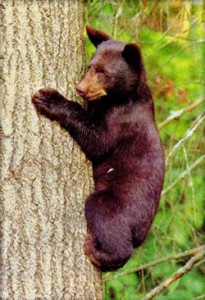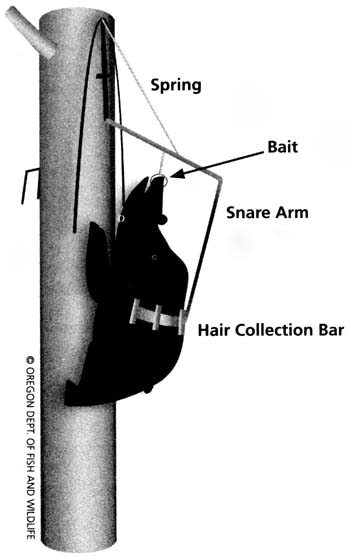Black Bear Census Set to Begin: Park to Estimate Population Using Hair Samples and DNA
Reflections Visitor Guide
Crater Lake National Park
Summer/Fall 2009
National Park Service
How many black bears live in Crater Lake National Park? Right now, your guess is as good as anyone’s! While park visitors and staff experience occasional sightings, nobody knows how many black bears (Ursus americanus) actually call the park home. This summer, however, the park’s newly established wildlife program will attempt to answer this question by gathering samples of black bear hair from across the park and analyzing the DNA within the hair.
Greg Holm is the park’s new (and first-ever) wildlife biologist. Holm, who holds a masters degree in Zoology from the University of Wyoming, has spent years studying and managing bears. This July and August, Holm and three summer employees will attempt to capture hair from each of the park’s resident bears using a “bear hair snare” technique developed by the Oregon Department of Fish and Wildlife.
 Biologist Holm and his staff plan to assemble 120 snares and place them throughout the park according to a grid system. Since female black bears in this part of Oregon are believed to have a home range of roughly 1.7 square miles (4.4 square km), the crew will need to distribute enough snares so that at least one is located in every potential home range. (Male black bears have a larger home range, typically patrolling an area 2 to 3 times that of females.)Funding for the project comes, in part, through purchases made by the public in the park’s visitor centers. The Crater Lake Natural History Association, a non-profit organization that operates the visitor center bookstores, has donated $4,500 from bookstore sales to buy materials needed to construct the snares.
Biologist Holm and his staff plan to assemble 120 snares and place them throughout the park according to a grid system. Since female black bears in this part of Oregon are believed to have a home range of roughly 1.7 square miles (4.4 square km), the crew will need to distribute enough snares so that at least one is located in every potential home range. (Male black bears have a larger home range, typically patrolling an area 2 to 3 times that of females.)Funding for the project comes, in part, through purchases made by the public in the park’s visitor centers. The Crater Lake Natural History Association, a non-profit organization that operates the visitor center bookstores, has donated $4,500 from bookstore sales to buy materials needed to construct the snares.
The crew will attach each snare to a tree trunk, 8 to 10 feet (2.4 to 3 meters) off the ground, then dangle from it a packet of scented, long-lasting bait. Bears, with their excellent sense of smell, will be lured to the trees and begin to climb. When a bear pulls at the bait, a hair-collection bar will be pulled down onto its back. The snare won’t injure or trap the bear, but as the bear descends the tree, carpet tacks embedded in the hair collection bar will snag bits of fur. “It’s like dragging a comb up the animal’s back,” describes Holm.
After two weeks, Holm’s crew will return to all 120 sites. For each snare visited by a bear, they will collect the residual fur with forceps, put it in an envelope, and reset the hair snare contraption. Over the course of the summer, they wiIl sample each site three times. At summer’s end, Holm will ship the hair to a genetics lab, which, through DNA analysis, should be able to determine the number of individual bears that “donated” hair to the study.
In addition to helping estimate the abundance of bears in the park, the survey will provide information about the bears’ distribution. Holm suspects that more bears will be found utilizing the wetter, western side of the park than the drier, eastern side, due to the greater presence and variety of shrubs. Black bears are omnivores but feed mainly on vegetation, such as berries. It’s likely that the results of the census will also raise new questions, helping to direct future research efforts.
So, if you’re wondering how many black bears live in Crater Lake National Park, check back next summer. In the meantime, take a piece of paper and write down your guess, so that you can compare it with our results.


